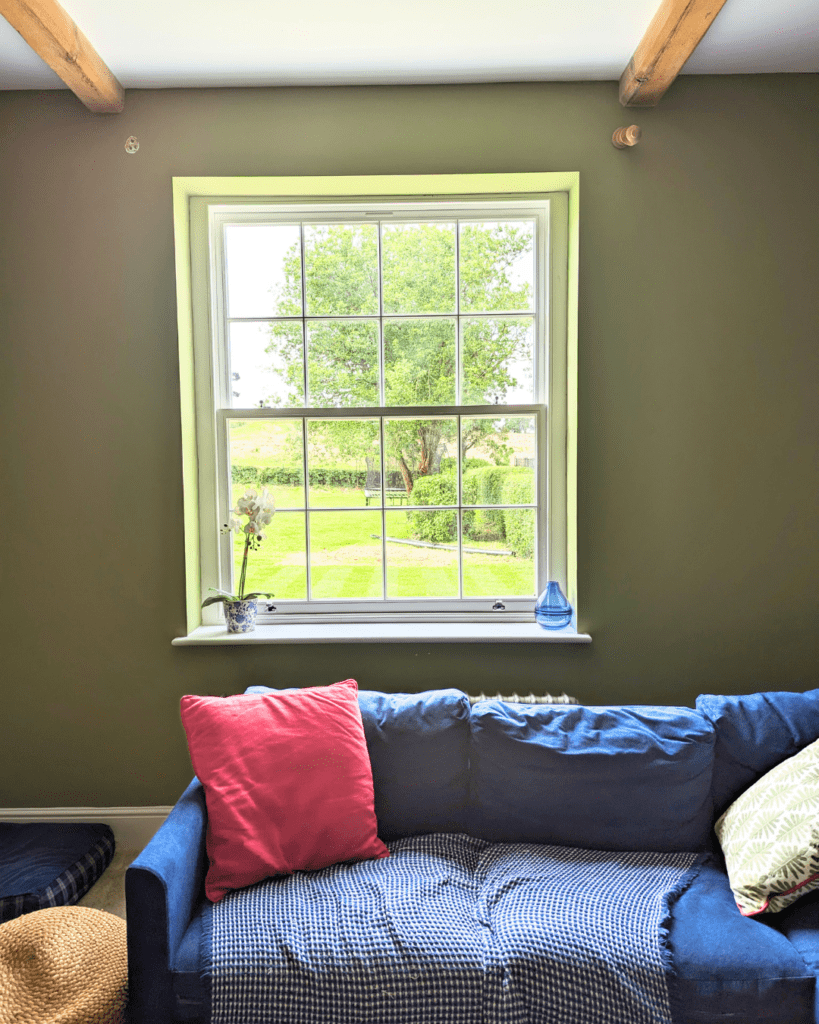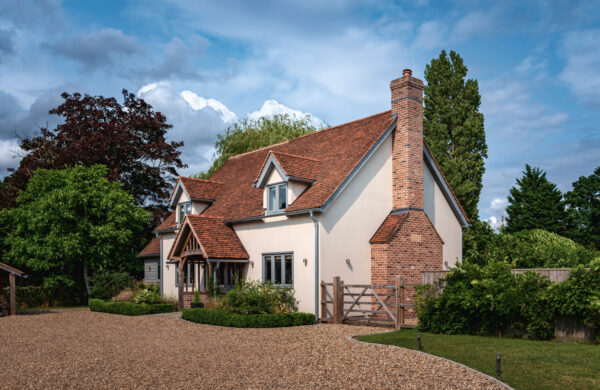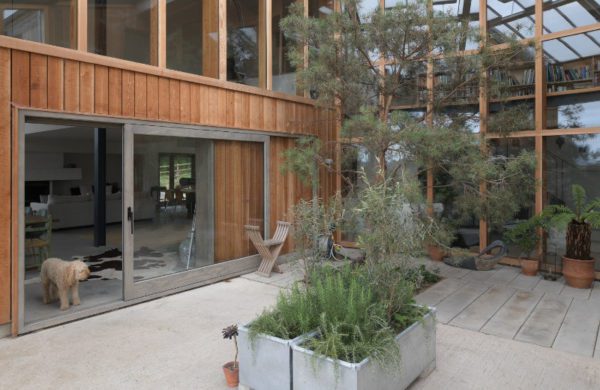
In 2021, an 1840s model farm in South Derbyshire underwent a remarkable transformation. This Grade II listed building (that was originally built for a local lord’s luncheon retreat during hunting trips) set a historic precedent by becoming the first in the region to have vacuum glazed windows approved. The completed Newton Park Farm seamlessly blends heritage conservation with cutting-edge technology.
Replacing the current windows is necessary if they are beyond repair.
“The windows were shot. Completely rotten, built in the 1970s out of fast-grown timber. It was so bad you could put your hand through most of the sills. And all single glazed too! Really draughty.
We hadn’t moved in at that point, but an elderly lady was living in it like that. She’d attempted to fill the gaps with a sort of papier mâché concoction.”
Ben, Homeowner
A building’s listed status usually dictates like-for-like windows, if the windows are deemed an important feature. This covers material, design and size.
“That’s what was there originally so we had to copy that,” he stated.
Finding a heritage window company that also offers high-performance windows is no small task, as many suppliers fall short in balancing historical accuracy with modern efficiency.
Ben purchased the farm to make it an ideal home for his family. Therefore, it needed to be warm and comfortable. However doing this within strict planning restrictions (that often deny double glazing) can prove problematic.
Initially, he considered various other options, including some well-known names from trade shows and smaller joineries. Both fell short due to performance or look.
Keen to find heritage windows and doors that met his goals, Ben put his engineering expertise to work. He painstakingly searched for pioneering technology that had the right heritage look.
“We chose Gowercroft because other companies could only offer standard double glazing that wouldn’t have worked in our house or met the planning permission standards”
Gowercroft’s offerings, particularly Accoya wood and LandVac vacuum glazing, played a significant role in cementing his decision. “I had heard a bit about Accoya but didn’t know the details. Joe from our team had explained how the treatment of the wood prevents rot by blocking the pores, making it highly effective for sash windows,” Ben recalled.
He was also impressed with our water-based microporous paint coatings, which, unlike oil-based coatings, do not detach or peel.
Owning a fabrication business, Ben knows a thing or two about engineering. With his team, he put our sample window through a rigorous evaluation process. Staying at his workshop for about a month, the sample underwent a thorough evaluation.
“When the sample was dropped off, about ten of us, including myself, a painter from a joinery company, and my right-hand man who used to run a joinery company, gathered around it. We inspected everything from aesthetics to build quality.”
Ben, Homeowner
The final decision came when his team agreed “That’s about the best you’re going to get.”
Ben felt confident in choosing our high-quality products, even though we weren’t the cheapest option on the market. “Quality costs,” Ben acknowledged, appreciating the value of investing in top-tier materials and craftsmanship for his heritage property.


Why Use Accoya Wood for Heritage Timber Windows?
Accoya wood was chosen for its durability and resistance to rot, ideal for the sash windows of a historic property.
“I’d heard there was a wood that was treated that shouldn’t rot,” Ben recalled. Further discussions about the benefits of water-based microporous paint coatings over oil-based options solidified his choice. He particularly liked the idea of it being a ‘top up rather than a strip everything down and repaint job”.
The use of vacuum glazing had been a game-changer for this Grade II listed property.
Ben explained the appeal, “People loved the concept of that vacuum glass; you could have both—it looked single glazed and was efficient. So it ticked the box for both us and the planner.”
Also, vacuum glazing was pivotal for its ability to look like single glazing while providing the thermal efficiency of modern double-glazed windows, a crucial factor in gaining planning approval.
“This was the first time that vacuum glazing was approved for Grade II listed in South Derbyshire—setting a precedent for the rest of the planning authority.”
Ben, Homeowner
However, some adjustments were required to get there.
The planning officer did not like the seal colour, which was quickly changed to match. They were also initially nervous about the glazing bar system, favouring pass through bars.
Pass through bars involve multiple smaller panes of glass with bars between them.
Pass through bars would have caused two major problems:
Modern alternatives such as astragal bars and planton bars have been known to look different to originals or have lack durability, causing widespread reluctance from planning officers.
Ben and Gowercroft were keen to find an innovative solution to this issue.
Gowercroft’s product development team got to work and created integrated conservation bars. This solution passed planning approval and has proved a key selling point of our Heritage Range.
Instead of individual bars stuck to the window, this method incorporates a grid of glazing bars that are “machine fixed’ to the frame, ensuring they remain secure and intact. The planners were also impressed with how the windows were finished, painted as a single unit to closely mimic an authentic, traditional look. This finish made it difficult to spot the gap, so only someone specifically looking for it would notice.
Ben appreciated this innovation and responsiveness to feedback, noting, “It’s a big plus point – we had bars that fell off in our old house and it was a real pain. These don’t.”
The installation of new windows by Gowercroft Joinery had dramatically transformed the property, both aesthetically and functionally.
Ben enthusiastically described the effect, “The difference is night and day. Fenestration is the face of the house! It looks great.”

Beyond the improved appearance, the thermal performance of the windows has significantly improved, a crucial factor for the comfort of the family.
Ben discusses the technical aspects with pride, specifically the U-value improvements, “We do bang on about the 1.2 U-value, so even better than building regs.”
This improvement is not only compliance with current building regulations but a substantial leap beyond them. Replacing the windows has madethe house was warm and energy-efficient, despite its large size and historical construction.
How does Gowercroft Joinery’s Customer Service Compare to Others?
Ben’s experience with Gowercroft’s customer service had been overwhelmingly positive: “Despite initial delays with the glazing bars and importing the glass, it was great,” Ben explained. He praised Gowercroft’s quick responses, problem-solving efforts, and transparency, noting how these qualities turned potential problems into positive experiences.
Ben’s experience with Gowercroft was a refreshing contrast to past providers, especially a kitchen company where he felt shuffled between contacts with no clear communication. “The sales side for them was just horrendous,” he recalled, noting high-pressure tactics and a lack of consistency. With Gowercroft, however, he experienced a seamless, personal approach. “With you, there was no being passed on with no link, it was very clear,” Ben shared, appreciating the continuity and attentive service he received throughout the process.
Ben found Gowercroft’s aftercare impressive, especially in how we promptly addressed issues post-installation.
This included repainting adjustments after he decided to change colours. “You guys came and repainted when we shotblasted…and now that I’ve decided to repaint my door, we just emailed and sorted it,” he noted, appreciating the smooth, hassle-free support and the ease of resolving these final details.
Ben stresses that choosing the cheapest option isn’t ideal for heritage projects. His experience with Gowercroft confirmed that quality is essential. “Pay the extra money, they’re worth it!” he advised, highlighting that the investment in durable, well-crafted windows ensures lasting value and satisfaction. “Anyone who asks me, I do rave about you…they really know what they’re doing,” he shared, emphasising his confidence in Gowercroft’s expertise and craftsmanship.
Featured Windows and Doors
The renovation of the Grade II listed property featured a combination of high-quality windows and doors from Gowercroft Joinery. Specifically, the project included a total of 20 windows, comprising of both Richmond Heritage Casement Windows and Winston Heritage Sliding Sash Windows. Additionally, three Churchill Heritage Doors were installed, seamlessly integrating the heritage aesthetic with modern performance.

Innovative window design and industry awards This iconic project, which spans a 60m x 8m plot serves as a new…
Read More
A North Essex Case Study on Energy Efficient Design and Renewable Materials This stunning oak-framed cottage in a North Essex…
Read More
Owners Vanessa & Bruce Jones had always wanted to build their own home in the countryside, so they were delighted…
Read More